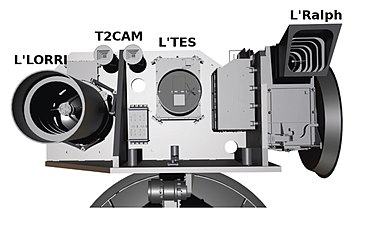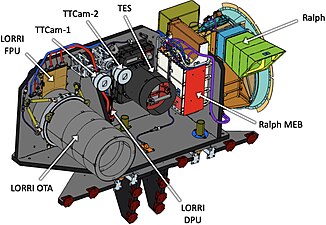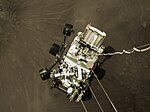cosmos.wikisort.org - Spacecraft
Lucy is a NASA space probe on a twelve-year journey to eight different asteroids, visiting a main belt asteroid as well as seven Jupiter trojans,[3][4] asteroids which share Jupiter's orbit around the Sun, orbiting either ahead of or behind the planet. All target encounters will be flyby encounters.[5] The Lucy spacecraft is the centerpiece of a US$981 million mission.[6]
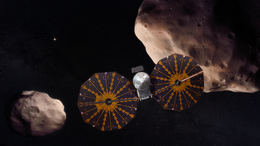 Artist's conception of Lucy spacecraft flying past the Trojan asteroid 617 Patroclus and its binary companion Menoetius | |
| Names | Discovery Mission 13 |
|---|---|
| Mission type | Multiple-flyby of asteroids |
| Operator | NASA Goddard · SwRI |
| COSPAR ID | 2021-093A |
| SATCAT no. | 49328 |
| Website | lucy |
| Mission duration | 12 years (planned) 1 year, 1 month and 2 days (in progress) |
| Spacecraft properties | |
| Manufacturer | Lockheed Martin |
| Launch mass | 1,550 kg (3,420 lb) |
| Dry mass | 821 kg (1,810 lb) |
| Dimensions | 13 m (43 ft) in long [1] Each solar panel: 7.3 m (24 ft) in diameter |
| Power | 504 watts (furthest encounter) |
| Start of mission | |
| Launch date | 16 October 2021, 09:34:00.192 UTC[2] |
| Rocket | Atlas V 401 (AV-096) |
| Launch site | Cape Canaveral, SLC-41 |
| Contractor | United Launch Alliance |
| Instruments | |
| High-resolution visible imager (L'LORRI) Optical and near-infrared imaging spectrometer (L'Ralph) Thermal infrared spectrometer (L'TES) | |
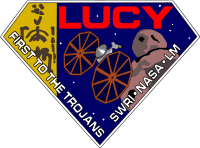 Lucy mission patch Discovery Program | |
On 4 January 2017, Lucy was chosen, along with the Psyche mission, as NASA's Discovery Program missions 13 and 14 respectively.[5][7]
The mission is named after the Lucy hominin fossils, because study of the trojans could reveal the "fossils of planet formation": materials that clumped together in the early history of the Solar System to form planets and other bodies.[8] The hominid was named after the 1967 Beatles song "Lucy in the Sky with Diamonds".[9] The spacecraft carries a disc made of lab-grown diamonds for its L'TES instrument.[10]
Overview

Lucy was launched from Cape Canaveral SLC-41 on 16 October 2021, at 09:34:00.192 UTC[2] on the 401 variant of a United Launch Alliance Atlas V launch vehicle. It gained one gravity assist from Earth on the 16th of October, 2022,[11] and it will gain another in 2024.[12] In 2025, it will fly by the inner main-belt asteroid 52246 Donaldjohanson, which was named after the discoverer of the Lucy hominin fossil.[13] In 2027, it will arrive at the L4 Trojan cloud (the Greek camp of asteroids that orbits about 60° ahead of Jupiter), where it will fly by four Trojans, 3548 Eurybates (with its satellite), 15094 Polymele, 11351 Leucus, and 21900 Orus.[5] After these flybys, Lucy will return to Earth in 2031 for another gravity assist toward the L5 Trojan cloud (the Trojan camp which trails about 60° behind Jupiter), where it will visit the binary Trojan 617 Patroclus with its satellite Menoetius in 2033. The mission may end with the Patroclus–Menoetius flyby, but at that point Lucy will be in a stable, 6-year orbit between the L4 and L5 clouds, and a mission extension will be possible.
Three instruments comprise the payload: a high-resolution visible imager, an optical and near-infrared imaging spectrometer, and a thermal infrared spectrometer.[14] Harold F. Levison of the Southwest Research Institute in Boulder, Colorado is the principal investigator, with Cathy Olkin of Southwest Research Institute as the mission's deputy principal investigator. NASA's Goddard Space Flight Center will manage the project.
Exploration of Jupiter Trojans is one of the high-priority goals outlined in the Planetary Science Decadal Survey. Jupiter Trojans have been observed by ground-based telescopes and the Wide-field Infrared Survey Explorer to be "dark with... surfaces that reflect little sunlight".[15] Jupiter is 5.2 AU (780×106 km; 480×106 mi) from the Sun, or about five times the Earth-Sun distance.[16] The Jupiter Trojans are at a similar distance but can be somewhat farther or closer to the Sun depending on where they are in their orbits. There may be as many Trojans as there are asteroids in the asteroid belt.[17]
Development
NASA selected Lucy through the Discovery Program AO released on 5 November 2014.[18] Lucy was submitted as part of a call for proposals for the next mission(s) for Discovery Program that closed in February 2015. Proposals had to be ready to launch by the end of 2021. Twenty-eight proposals were received in all.
On 30 September 2015, Lucy was selected as one of five finalist missions, each of which received US$3 million to produce more in-depth concept design studies and analyses.[19][20][21][22] Its fellow finalists were DAVINCI, NEOCam, Psyche and VERITAS. On 4 January 2017, Lucy and Psyche were selected for development and launch.
On 31 January 2019, NASA announced that Lucy would launch in October 2021 on an Atlas V 401 launch vehicle from Cape Canaveral, Florida. The total cost for the launch is estimated to be US$148.3 million.[23] On 11 February 2019, SpaceX protested the contract award, claiming that it could launch Lucy into the same orbit at a "significantly cheaper cost". On 4 April 2019, SpaceX withdrew the protest.[24]
On 28 August 2020, NASA announced that Lucy had passed its Key Decision Point-D (KDP-D) with a "green light" to assemble and test the spacecraft and its instruments.[25] The spacecraft instruments arrived beginning with L'LORRI on 26 October 2020.[26] On 30 July 2021, the spacecraft was transported on a C-17 transport aircraft to Florida for launch preparations, and Lucy was encapsulated into the rocket fairing on 30 September 2021.
Lucy was launched on 16 October 2021 at 09:34 UTC[27][28] at the opening of its 23-day launch window.[28]
Scientific instruments
The science payload includes:[1][19]

- L'Ralph – panchromatic and color visible imager (0.4–0.85 μm) and infrared spectroscopic mapper (1–3.6 μm). L'Ralph is based on the Ralph instrument on New Horizons and was built at Goddard Space Flight Center. It will be used to measure silicates, ices, and organics at the surface. The L'Ralph instrument has a three-mirror anastigmat design f/6 with a 75 mm aperture. The telescope structure is composed from one aluminum block to provide an athermal imaging system. A beamsplitter transmits the longer wavelength light to LEISA and reflects light short of ∼960 nm to MVIC. The instrument is passively cooled with a 20-inch diameter radiator that cools the LEISA detector to ∼100 K. A new component of the L'Ralph instrument compared with its predecessors is a scan mirror assembly. The scan mirror is used to sweep the target across the Ralph focal planes to build up either visible images or infrared spectra.[29]

- L'LORRI – high-resolution visible imager. L'LORRI is derived from the LORRI instrument on New Horizons and was built at the Johns Hopkins University Applied Physics Laboratory. It will provide the most detailed images of the surface of the Trojans. L'LORRI uses the same detector and has the same optical design as New Horizons LORRI. The primary mirror has a diameter of 20.8 cm, the system has a focal length of 262 cm, and the detector is a 1024 × 1024 thinned back-illuminated frame transfer CCD from Teledyne e2v. Each pixel subtends 5 μrad and will have a point-spread function with a FWHM of less than 15 μrad. Differences from the heritage instrument worth noting are the addition of redundant electronics, memory to store LORRI data, and the difference in the instrument accommodation. On New Horizons, the LORRI instrument is inside of the spacecraft, but on Lucy L'LORRI is mounted on an Instrument Pointing Platform (IPP).[29]

- L'TES – thermal infrared spectrometer (6–75 μm). L'TES is similar to OTES on the OSIRIS-REx mission and was built at Arizona State University. It will reveal the thermal characteristics of the observed Trojans, which will also inform the composition and structure of the material on the surface of the asteroids. OTES was used to derive the surface composition and thermal inertia of the asteroid Bennu. However, because the Trojan asteroids at 5 au are much colder than Bennu, the Lucy mission does not plan to use L'TES to derive surface composition. Instead, L'TES will be used primarily to infer regolith properties. L'TES has the same optical–mechanical design as OTES, including a 15.2 cm diameter Cassegrain telescope, a Michelson interferometer with chemical vapor deposited diamond beamsplitter, and an uncooled, deuterated L-alanine doped triglycine sulfate (DLATGS) pyroelectric detector. L'TES has only small differences from the heritage instrument including removing a potential stray light path by modifying the telescope baffle and primary mirror inner diameter and improvements to the metrology laser system. An internal calibration cone blackbody target provides radiometric calibration. The L'TES instrument collects data from 6–75 μm and has a noise equivalent spectral radiance (NESR) of 2.310−8 W cm−2 sr−1/cm−1 between 300 cm−1 (7.4 μm) and 1350 cm−1 (33 μm). For surfaces with temperatures greater than 75K, L'TES will determine the temperature with an accuracy of 2K. The 50% encircled energy of the instrument subtends 6.5 mrad. L'TES has one mode of taking data. It continuously collects interferograms (every 0.5, 1.0, or 2.0 s) and transfers them to the spacecraft for storage before downlink. The instrument will start collecting data one day before closest approach, which is before the target fills the instrument's FOV. The data collection will continue until one day after closest approach. The L'TES instrument will measure the radiance of each Trojan asteroid at four locations at different local times of day with the additional requirement that one observation measures a location within 30° of the subsolar point and another measures the unilluminated surface.[29]
- The radio science investigation will determine the mass of the Trojans by using the spacecraft radio telecommunications hardware and high-gain antenna to measure Doppler shifts.
- T2CAM – terminal tracking camera (T2CAM or TTCAM) would be used to take wide-field images of the asteroids to better constrain the asteroids shapes.
- Illustration of the deployed spacecraft
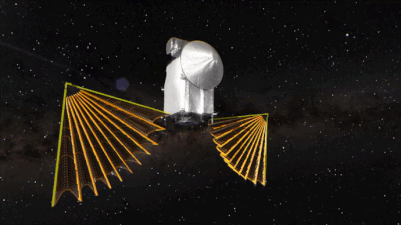 Lucy spacecraft solar arrays deploying and main engine burn
Lucy spacecraft solar arrays deploying and main engine burn- Instruments onboard
- The Instrument Pointing Platform (IPP)
Golden Plaque

Onboard the spacecraft is a golden plaque that contains its launch date, the positions of the planets at the launch date, the continents of Earth at the time of launch, its nominal trajectory, and twenty speeches, poems, and song lyrics from people such as Martin Luther King Jr., Carl Sagan, The Beatles, and more. Because the spacecraft will not leave the Solar System or be ditched into a planetary body, there is a chance that future generations of humanity will be able to recover it.[30]
Targets


The specific asteroids that are targeted for flyby observation passes performed by the spacecraft include:[13][31][32][33]
| Encounter date | Target | Group | Diameter | Altitude | Classification | Comment |
|---|---|---|---|---|---|---|
| 16 October 2022 | Earth | Terrestrial planets | 12 742 km | 300 km | Terrestrial planet | Gravity assist Centaur booster was detected by asteroid surveys and was mistakenly designated 2022 UQ1. |
| 13 December 2024 | Earth | Terrestrial planets | 12 742 km | 350 km | Terrestrial planet | Gravity assist |
| 20 April 2025 | 52246 Donaldjohanson | Inner main belt | 4 km | 922 km | C-type asteroid | Member of ~130 Myr old Erigone collisional family |
| 12 August 2027 | 3548 Eurybates | Greek camp at L4 | Eurybates: 64 km (Queta satellite: 1 km) | 1000 km | Binary C-type asteroid | Largest member of the only confirmed disruptive collisional family in the Trojans. |
| 15 September 2027 | 15094 Polymele | Greek camp at L4 | Polymele: 21 km (Satellite: 5 km) | 415 km | Binary P-type asteroid | May be a collisional fragment of a larger P-type asteroid. Its red color suggests surface is rich in organic tholin compounds. |
| 18 April 2028 | 11351 Leucus | Greek camp at L4 | 34 km | 1000 km | D-type asteroid | Slow rotator taking 466 hours per rotation. |
| 11 November 2028 | 21900 Orus | Greek camp at L4 | 51 km | 1000 km | D-type or C-type asteroid according to the Lucy mission team and by Pan-STARRS photometric survey, respectively. | Possible binary[34] |
| 26 December 2030 | Earth | Terrestrial planets | 12 742 km | 660 km | Terrestrial planet | Gravity assist. First spacecraft to go as far as Jupiter's orbit and return to the vicinity of the Earth.[35] |
| 2 March 2033 | 617 Patroclus-Menoetius | Trojan camp at L5 | Patroclus: 113 km Menoetius: 104 km | 1000 km | Binary P-type asteroids[36] | The pair orbit at a separation of 680 km |
Flight



Although the Lucy concept originated in late 2014, and was selected for funding in 2015, the Lucy spaceflight began on 16 October 2021 with the launch of the Lucy spacecraft aboard a United Launch Alliance Atlas V 401 launch vehicle[37] into a stable parking orbit. During the next hour, the second stage reignited to place Lucy on an interplanetary trajectory in a heliocentric orbit on a twelve-year mission to two groups of Sun-Jupiter Trojan asteroids as well as a close flyby of a main belt asteroid during one of three planned passes through the asteroid belt. If the spacecraft remains operational during the 12-year planned duration, it is likely the mission will be extended and directed to additional asteroid targets.[38][39]
On October 16, 2021 Lucy began to unfurl its two solar arrays. While the initial deployment of the arrays appeared to go smoothly, it was later discovered that one of the solar arrays failed to securely latch into open position. Thomas Zurbuchen, NASA's associate administrator for science, stressed the spacecraft remained "safe and stable".[40] Later testing on October 26 indicated the affected array was between 75 and 95 percent of full deployment. As of January 2022[update], the spacecraft is in cruise mode. NASA has stated they are reviewing a range of potential options, including simply letting the array remain as it is.[41][42] In late January 2022 NASA announced that they had found out the cause why one of the solar arrays did not deploy fully and latch open securely; at the time, the agency's view was that there were two options to proceed: try to redeploy the solar array by some more running of the motor that pulled the array open, trying to get the array to deploy fully and latch into place, or as the other option, leave the array as is, not trying to fully open it. Even with one solar array only partially deployed, the spacecraft was generating enough power for the mission. NASA said it would consider thoroughly its options and only take action at a (much) later time, as the issue was not an imminent risk to the mission.[43]
On May 9, 2022 Lucy executed its first step in completing the deployment of the unlatched solar array. This first step was intended to validate that the team's ground testing adequately represented the flight system's performance and was not meant to fully latch the array. After reviewing the data, the next step will be another deployment effort to fully latch the solar array.[44][45]

21900 Orus

Jupiter
See also
- DESTINY+, a planned JAXA mission to flyby multiple asteroids.
- Jupiter Icy Moons Explorer, a planned ESA mission to the Jupiter system.
- OKEANOS, a proposed solar sail mission to Jupiter Trojans.
- 2022 UQ1, a minor planet provisional designation mistakenly given to Lucy's Centaur upper stage during its October 2022 Earth gravity assist.
References
- "The Lucy Spacecraft and Payload". Southwest Research Institute. 9 July 2018.
- "U.S. Launch Schedule". NASASpaceflight.com. 16 October 2021. p. 206. Retrieved 21 October 2021.
- Hille, Karl (21 October 2019). "NASA's Lucy Mission Clears Critical Milestone". NASA. Retrieved 5 December 2020.
 This article incorporates text from this source, which is in the public domain.
This article incorporates text from this source, which is in the public domain. - "Lucy: The First Mission to the Trojan Asteroids". NASA. 21 April 2017. Retrieved 16 October 2021.
 This article incorporates text from this source, which is in the public domain.
This article incorporates text from this source, which is in the public domain. - Chang, Kenneth (6 January 2017). "A Metal Ball the Size of Massachusetts That NASA Wants to Explore". The New York Times.
- "Watch a video tour of NASA's Lucy asteroid explorer". Spaceflight Now. 6 October 2021. Retrieved 7 October 2021.
- Northon, Karen (4 January 2017). "NASA Selects Two Missions to Explore the Early Solar System". NASA.
 This article incorporates text from this source, which is in the public domain.
This article incorporates text from this source, which is in the public domain. - Witze, Alexandra (16 March 2015). "Five Solar System sights NASA should visit". Nature.
- Johanson, Donald C.; Wong, Kate (2010). Lucy's Legacy: The Quest for Human Origins. Crown Publishing Group. pp. 8–9. ISBN 978-0-307-39640-2.
- "NASA's asteroid hunter Lucy soars into the sky with diamonds". Los Angeles Times. 16 October 2021. Retrieved 16 October 2021.
- Lee Kanayama (16 October 2022). "Lucy completes its first Earth gravity assist after a year in space". www.nasaspaceflight.com. NASA Spaceflight.com. Retrieved 24 October 2022.
- "NASA Awards Launch Services Contract for Lucy Mission". nasa.gov. NASA. 31 January 2019. Retrieved 29 March 2021.
{{cite web}}: CS1 maint: url-status (link) This article incorporates text from this source, which is in the public domain.
This article incorporates text from this source, which is in the public domain. - Dreier, Casey; Lakdawalla, Emily (30 September 2015). "NASA announces five Discovery proposals selected for further study". The Planetary Society.
- Leibold, Rob (2 October 2015). "SwRI awarded US$3 million NASA contract to develop mission to Jupiter's Trojan asteroids" (Press release). Southwest Research Institute.
- "PIA16211: Trojan Colors Revealed (Artist's Concept)". NASA. 15 October 2012.
 This article incorporates text from this source, which is in the public domain.
This article incorporates text from this source, which is in the public domain. - Wall, Jennifer (1 June 2015). "What Is Jupiter?". NASA.
 This article incorporates text from this source, which is in the public domain.
This article incorporates text from this source, which is in the public domain. - Dreier, Casey; Lakdawalla, Emily (30 September 2015). "NASA announces five Discovery proposals selected for further study". The Planetary Society.
- "FY 2021 PRESIDENT'S BUDGET REQUEST SUMMARY" (PDF). NASA. Retrieved 29 March 2021.
{{cite web}}: CS1 maint: url-status (link) This article incorporates text from this source, which is in the public domain.
This article incorporates text from this source, which is in the public domain. - Leibold, Rob (2 October 2015). "SwRI Awarded US$3 Million NASA Contract To Develop Mission To Jupiter's Trojan Asteroids" (Press release). Southwest Research Institute.
- Brown, Dwayne C.; Cantillo, Laurie (30 September 2015). "NASA Selects Investigations for Future Key Planetary Mission". NASA.
 This article incorporates text from this source, which is in the public domain.
This article incorporates text from this source, which is in the public domain. - Clark, Stephen (24 February 2014). "NASA receives proposals for new planetary science mission". Spaceflight Now.
- Kane, Van (2 December 2014). "Selecting the Next Creative Idea for Exploring the Solar System". The Planetary Society.
- "NASA Awards Launch Services Contract for Lucy Mission". NASA. 31 January 2019.
 This article incorporates text from this source, which is in the public domain.
This article incorporates text from this source, which is in the public domain. - Foust, Jeff (5 April 2019). "SpaceX drops protest of NASA launch contract". SpaceNews.
- Jones, Nancy (28 August 2020). "NASA's Lucy Mission One Step Closer to Exploring the Trojan Asteroids". NASA. Retrieved 16 October 2021.
- "Johns Hopkins APL Delivers First Instrument for NASA's Lucy Mission | APL Civil Space". civspace.jhuapl.edu. Retrieved 1 October 2021.
- "NASA's Lucy Mission Prepares for Launch to Trojan Asteroids" (Press release). NASA. 28 September 2021. Retrieved 29 September 2021.
 This article incorporates text from this source, which is in the public domain.
This article incorporates text from this source, which is in the public domain. - Fox, Karen; Johnson, Alana; Jones, Nancy (16 October 2021). "NASA, ULA Launch Lucy Mission to "Fossils" of Planet Formation". NASA. Retrieved 16 October 2021.
 This article incorporates text from this source, which is in the public domain.
This article incorporates text from this source, which is in the public domain. - Olkin, Catherine B.; Levison, Harold F.; Vincent, Michael; Noll, Keith S.; Andrews, John; Gray, Sheila; Good, Phil; Marchi, Simone; Christensen, Phil; Reuter, Dennis; Weaver, Harold; Pätzold, Martin; Iii, James F. Bell; Hamilton, Victoria E.; Russo, Neil Dello; Simon, Amy; Beasley, Matt; Grundy, Will; Howett, Carly; Spencer, John; Ravine, Michael; Caplinger, Michael (24 August 2021). "Lucy Mission to the Trojan Asteroids: Instrumentation and Encounter Concept of Operations". The Planetary Science Journal. doi:10.3847/PSJ/abf83f. Retrieved 2 May 2022.
 Material was copied from this source, which is available under a Creative Commons Attribution 4.0 International License
Material was copied from this source, which is available under a Creative Commons Attribution 4.0 International License - "The Lucy Plaque – Lucy Mission". lucy.swri.edu. Retrieved 5 October 2021.
- "Lucy: Surveying the Diversity of Trojan Asteroids, the Fossils of Planet Formation" (PDF). Southwest Research Institute. 2015. Retrieved 11 July 2017.
- Levison, H. F.; Olkin, C.; Noll, K. S.; Marchi, S. (March 2017). Lucy: Surveying the Diversity of the Trojan Asteroids, the Fossils of Planet Formation (PDF). 48th Lunar and Planetary Science Conference. 20–24 March 2017 The Woodlands, Texas. Bibcode:2017LPI....48.2025L. LPI Contribution No. 1964, id. 2025.
- "Mission Targets". Lucy. Southwest Research Institute. 25 June 2018.
- Noll, K. S.; Grundy, W. M.; Buie, M. W.; Levison, H. F.; Olkin, C.; Marchi, S.; Brown, M. E.; Mottola, S. (22 August 2018), 15622 – Confirmation of a Binary Companion to 21900 Orus (PDF), Space Telescope Science Institute
- "Lucy Mission". NASA. 30 April 2021. Retrieved 15 October 2021.
 This article incorporates text from this source, which is in the public domain.
This article incorporates text from this source, which is in the public domain. - Sanders, Robert (1 February 2006). "Binary asteroid in Jupiter's orbit may be icy comet from solar system's infancy" (Press release). University of California Berkeley.
- Warren, Haygen (16 October 2021). "NASA, ULA launch historic Lucy mission". NASASpaceFlight.com. Retrieved 26 October 2021.
- Derek 'DK' Knabenbauer, Haygen Warren, Chris Gebhardt, and Stephen Marr (15 October 2021). Asteroid Hunter: Lucy's Journey to the Trojan Asteroids (video). NASASpaceFlight.com. Retrieved 26 October 2021.
- SVS, NASA's (21 October 2019). "SVS: Lucy mission trajectory". svs.gsfc.nasa.gov. Retrieved 23 January 2022.
- Bartels, Meghan (18 October 2021). "NASA eyes solar array glitch on new Lucy asteroid spacecraft". Space.com. Retrieved 29 October 2021.
- "Lucy Cruising Outbound; Testing Solar Array Options on Ground – Lucy Mission". blogs.nasa.gov. Retrieved 23 January 2022.
- Fox, Karen (27 October 2021). "Lucy Stable in Cruise Mode". NASA. Retrieved 29 October 2021.
- "Cause of Lucy solar array deployment problem identified". 26 January 2022.
- Fox, Karen. "NASA's Lucy Mission Is "Go" for Solar Array Deployment Attempt". NASA.
- Morton, Erin. "NASA's Lucy Team Completes Step One of the Solar Array Deployment Attempt". NASA.
External links
- Mission website at NASA.gov
- NASA's New Discovery Missions: Psyche and Lucy on YouTube
- Lucy: NASA's mission to Jupiter's Trojans at eoPortal
- Designing Lucy’s Path to the Trojan Asteroids
На других языках
[de] Lucy (Raumsonde)
Vorlage:Infobox Sonde/Wartung/nssdc_id fehlt- [en] Lucy (spacecraft)
[es] Lucy (sonda espacial)
Lucy es una sonda espacial, proyecto de la NASA, cuyo objetivo es estudiar cinco asteroides troyanos de Júpiter, que orbiten tanto delante como detrás del planeta.[2][ru] Люси (космический аппарат)
Lucy («Лю́си») — миссия НАСА по изучению троянских астероидов Юпитера, которые обращаются вокруг Солнца за 60° до и после Юпитера[4]. Запуск с космодрома на мысе Канаверал состоялся 16 октября 2021 года[5].Другой контент может иметь иную лицензию. Перед использованием материалов сайта WikiSort.org внимательно изучите правила лицензирования конкретных элементов наполнения сайта.
WikiSort.org - проект по пересортировке и дополнению контента Википедии


